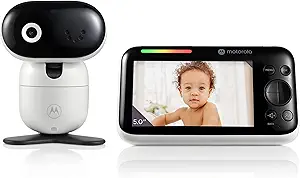Motorola and Babysense are two leading brands in the baby monitor industry, each offering a variety of models with advanced features to keep a check on your little ones. Motorola baby monitors are known for their high-quality video and audio capabilities, Wi-Fi connectivity, and temperature monitoring features. Some of the latest models also come with a 5-inch color screen, infrared night vision, and two-way communication, allowing parents to hear and speak to their baby from another room. However, some users have reported connectivity issues and short battery life as drawbacks. On the other hand, Babysense baby monitors are recognized for their non-contact monitoring technology. Their latest models come with an under-the-mattress movement sensor pad, which can detect even the slightest movements, including your baby's breathing. This feature provides an extra level of safety, alerting parents if no movement is detected for more than 20 seconds. Babysense monitors also offer two-way communication and infrared night vision, similar to Motorola. However, they lack Wi-Fi connectivity, which means you cannot monitor your baby from your smartphone or other devices. Some users also find the sensor pad to be overly sensitive, leading to false alarms. Both brands have their strengths and weaknesses, and the choice between them depends on the specific needs and preferences of the parents.
Key Features Comparison
Affordability
Motorola and Babysense baby monitors are both reputable brands in the baby monitor industry, each with its own pricing strategy. Motorola baby monitors are generally more expensive, with the latest models like Motorola Halo+ Over the Crib Wi-Fi Baby Monitor retailing at around $300. This high price is justified by the advanced features it offers such as infrared night vision, two-way communication, and a dedicated parent unit. Furthermore, Motorola baby monitors are integrated with smart technology, allowing them to connect to smartphones and tablets for real-time monitoring. On the other hand, Babysense baby monitors are more budget-friendly, with models like the Babysense Video Baby Monitor retailing at around $75. Despite the lower price, Babysense monitors still offer essential features such as two-way talkback, infrared night vision, and room temperature monitoring. However, they lack some of the advanced features found in Motorola monitors like Wi-Fi connectivity and smartphone integration. When compared to other brands in the market, both Motorola and Babysense offer competitive pricing, with Motorola leaning towards the high-end segment and Babysense catering to the more budget-conscious consumers.
Reputation
Motorola baby monitors have a strong reputation in the market for their advanced technology and reliable performance. They are known for their impressive range, clear video and audio quality, and their use of encrypted digital technology for security. The brand's latest models, such as the Motorola MBP36XL, even offer features like remote pan, tilt, and zoom, infrared night vision, and temperature monitoring. However, some users have reported issues with battery life and durability over time. In comparison to other brands, Motorola stands out for its innovative features and strong brand recognition. On the other hand, Babysense baby monitors are recognized for their high safety standards and simplicity. The brand specializes in movement monitors, like the Babysense 7, designed to alert parents if no movement is detected from the baby for more than 20 seconds. This technology has earned Babysense a reputation as a reliable choice for parents who are concerned about SIDS (Sudden Infant Death Syndrome). However, false alarms can sometimes be a problem with these types of monitors. Compared to other brands, Babysense may not offer as many high-tech features as Motorola, but they are highly regarded for their focus on safety and reliability.
Related Videos
Conclusion
Motorola baby monitors and Babysense baby monitors both offer advanced technologies to ensure the safety and comfort of your baby. Motorola baby monitors are known for their superior video quality and long-range connectivity. They often feature a 5-inch color screen, infrared night vision, and two-way communication, allowing parents to monitor their babies clearly even in the dark and communicate with them without being in the same room. However, some users have reported connectivity issues and short battery life as drawbacks. On the other hand, Babysense baby monitors are recognized for their non-contact monitoring technology that tracks a baby's breathing and movements. They are equipped with highly sensitive sensors that can detect even the slightest irregularities, triggering an alarm if no movement is detected for more than 20 seconds or if the breathing rate falls below a certain threshold. This can provide additional peace of mind for parents, especially those with newborns or infants with health concerns. However, false alarms can be a common issue with Babysense monitors, which can cause unnecessary panic. Comparatively, both brands offer unique features that cater to different needs and preferences, and the choice between the two would largely depend on what specific features a parent values most in a baby monitor.





















